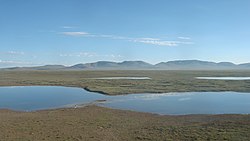Nagqu
那曲市 ནག་ཆུ་གྲོང་ཁྱེར། Nagchu | |
|---|---|
 Rural Nagqu | |
 Location of Nagchu Prefecture within China | |
| Coordinates (Nagqu municipal government): 31°28′34″N 92°03′04″E / 31.476°N 92.051°E | |
| Country | China |
| Autonomous region | Tibet |
| County-level divisions | a district and 10 counties |
| City seat | Seni District |
| Area | |
| • Total | 450,537 km2 (173,953 sq mi) |
| Population (2010)[1] | |
| • Total | 462,381 |
| • Density | 1.0/km2 (2.7/sq mi) |
| GDP | |
| • Total | CN¥ 9.5 billion US$ 1.5 billion |
| • Per capita | CN¥ 19,508 US$ 3,132 |
| Time zone | UTC+8 (China Standard) |
| ISO 3166 code | CN-XZ-06 |
| Website | www |
| Nagqu | |||||||
|---|---|---|---|---|---|---|---|
| Chinese name | |||||||
| Chinese | 那曲 | ||||||
| Hanyu Pinyin | Nàqū | ||||||
| |||||||
| Alternative Chinese name | |||||||
| Chinese | 黑河 | ||||||
| Hanyu Pinyin | Hēihé | ||||||
| |||||||
| Tibetan name | |||||||
| Tibetan | ནག་ཆུ། | ||||||
| |||||||
Nagqu (also Naqu, Nakchu, or Nagchu; Tibetan: ནག་ཆུ།, Wylie: Nag-chu, ZYPY: Nagqu; Chinese: 那曲; lit. 'black river') is a prefecture-level city in the north of the Chinese autonomous region of Tibet. On May 7, 2018, the former Nagqu Prefecture was officially declared the sixth prefecture-level city in Tibet after Lhasa, Shigatse, Chamdo, Nyingchi and Shannan. The regional area, covering an area of 450,537 km2 (173,953 sq mi), is bordered by Bayingolin and Hotan Prefectures of Xinjiang to the north, Haixi, Yushu Prefectures of Qinghai and Chamdo to the east, Nyingchi, Lhasa and Shigatse to the south, Ngari Prefecture to the west. As of the 2010 census, it had a population of 462,381.[1] Since its official establishment in 2018, it is the largest prefecture-level city by area in the world,[2] being slightly larger than Sweden.
Nagqu contains 89 townships, 25 towns, and 1,283 villages. The main city of Nagqu is along the China National Highway 109, 330 kilometres (210 mi) northeast of Lhasa. Amdo, Nyainrong and Xainza are other towns of note. Extremely rich in water resources, with 81% of Tibet's lakes, covering a total area of over 30,000 square kilometres (12,000 sq mi), it contains lakes such as Namtso, Siling Lake and rivers such as Dangqu.
Every August (the sixth month in the Tibetan calendar), Nagqu hosts the Kyagqen Horse Race, a major event locally attracting tens of thousands of herdsmen to participate in horseracing and archery contests.
- ^ a b Cite error: The named reference
Historywas invoked but never defined (see the help page). - ^ "那曲地区撤地设市--时政--人民网". politics.people.com.cn. Retrieved December 11, 2023.